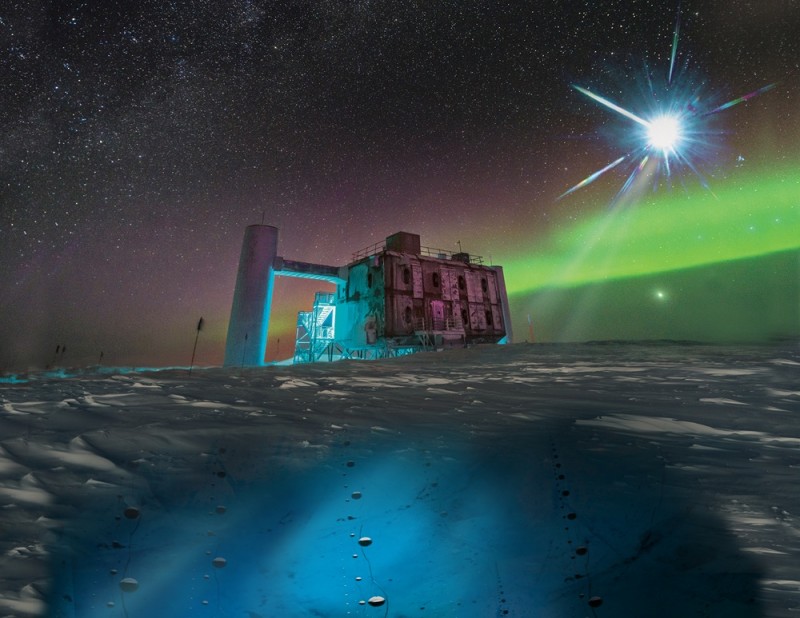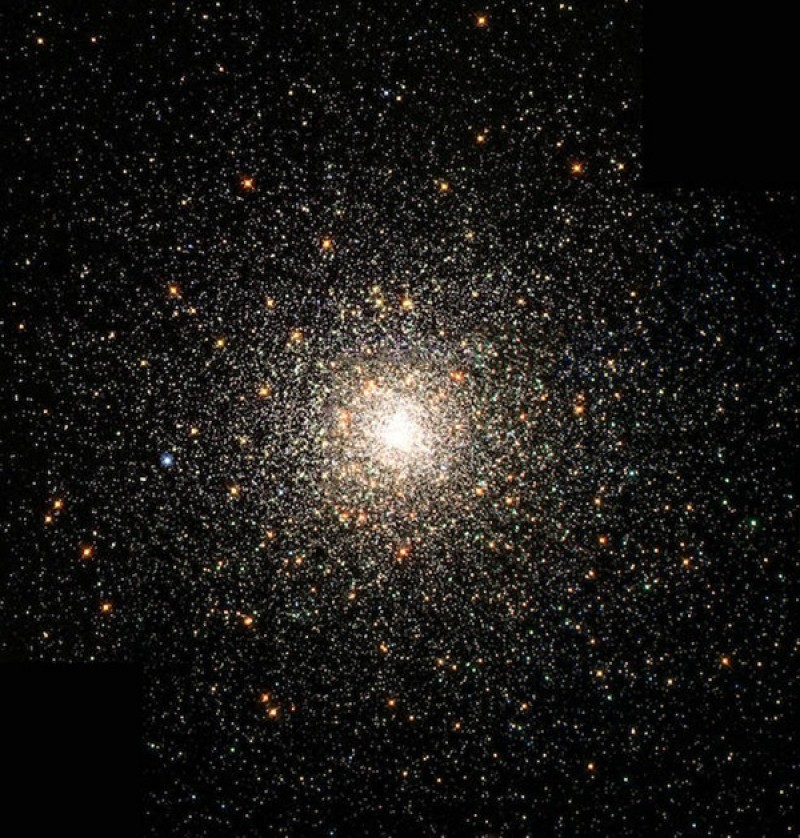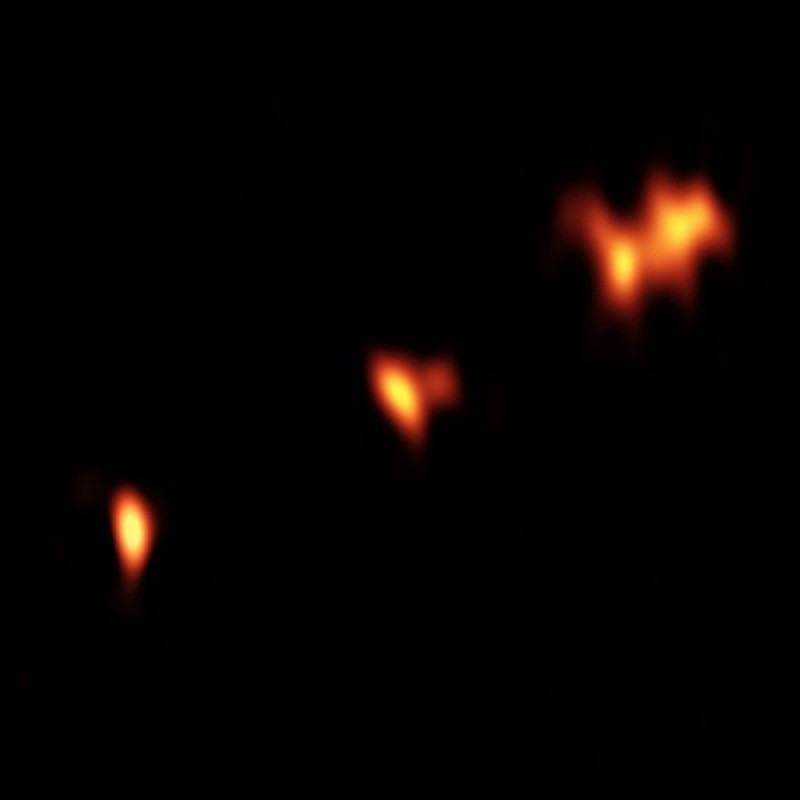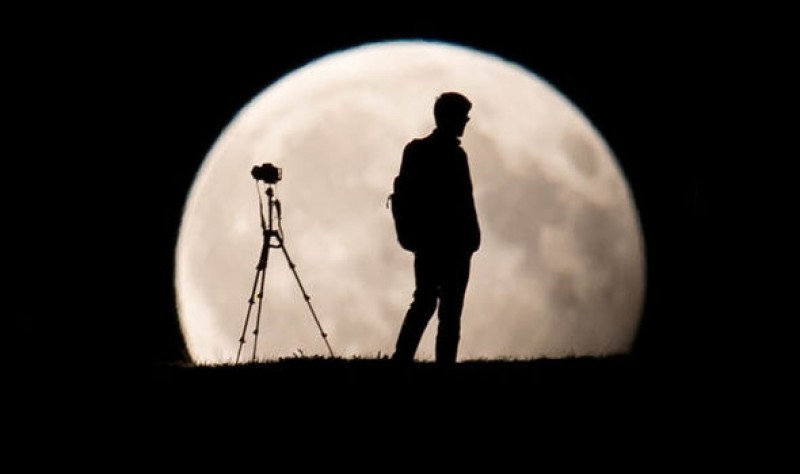News
A cosmic particle spewed from a distant galaxy strikes Earth
Thursday, July 12th 2018 05:51 PM
Four billion years ago, an immense galaxy with a black hole at its heart spewed forth a jet of particles at nearly the speed of light. One of those particles, a neutrino that is just a fraction of the size of a regular atom, traversed across the universe on a collision course for Earth, finally striking the ice sheet of Antarctica last September. Coincidentally, a neutrino detector planted by scientists within the ice recorded the neutrino’s charged interaction with the ice, which resulted in a blue flash of light lasting just a moment. The results are published today in the journal Science.This detection marks the second time in history that scientists have pinpointed the origins of a neutrino from outside of our solar system. And it’s the first time they’ve confirmed that neutrinos are created in the supermassive black holes at the centers of galaxies — a somewhat unexpected source.Neutrinos are highly energetic particles that rarely ever interact with ma...
Read More
Read More
Supermassive stars could explain globular clusters’ strange chemical compositions
Wednesday, July 11th 2018 04:12 PM
Unfair as it may be, not all stars in the Milky Way are created equal. Each subset has their own unique set of characteristics, like luminosity, size, temperature, and composition. And although our galactic diversity runs deep, one classification of stars sticks out more than others: globular clusters. The ancient stars in these tightly packed groups have chemical compositions unlike those of stars elsewhere in the galaxy, a distinct trait that’s perplexed astronomers for decades. Now, a study published in the Monthly Notices of the Royal Astronomical Society suggests a peculiar party is responsible for their unusual makeup — supermassive stars. Believed to have formed between 11 and 13 billions years ago, globular clusters are known as some of the oldest objects in the universe. There are more than 150 of these ancient clusters, each packed with hundreds of thousands of close-knit, gravity-bound stars, scattered about the Milky Way. Studies dating bac...
Read More
Read More
Crescent Moon And Venus To Bedazzle In Sunday’s Evening Sky
Tuesday, July 10th 2018 03:59 PM
Hanging dramatically in the west during twilight next Sunday evening (July 15, 2018) will be a bright “star” and crescent: Venus and the Moon. The cosmic couple will be quite the eye-catcher if your sky is clear.
Look for them due west as twilight fades. The best viewing will probably be from about 40 to 60 minutes after your local sunset time. Too early and the sky will still be too bright to display them well. Too late and they’ll be sinking very low on their way to setting.
Also, look carefully a little to their lower right for the star Regulus twinkling away. It’s slightly less than 1% as bright as Venus.
Moreover, you may also be able to catch the planet Mercury much farther to their lower right. A line from Venus through Regulus points straight to it. Binoculars will help. (All descriptions are for viewers in North America.)
How close together the Moon and Venus will actually appear depends on where you are. Seen at dusk in the Eastern time zone, the...
Read More
Read More
Astronomers Discover the Brightest Early Galaxy Ever
Monday, July 9th 2018 07:48 PM
The light in this image emanates from a supermassive black hole at the center of a galaxy 13 billion light-years away.
Momjian, et al.; B. Saxton (NRAO/AUI/NSF)
The early universe is a mystery. It’s quite literally surrounded by a veil that obscures its distant, early light. But a new glimmer through that void could give us a glimpse into this mysterious era.Two papers released in the Astrophysical Journal detail the discovery of a quasar dubbed PSO J352.4034-15.3373, or P352-15 for short. Quasars are the active centers of large galaxies where supermassive black holes shoot out jets of gas. The image is faint, but shows three distinct regions spreading across some 5,000 light years.Our universe is 13.8 billion years old; this quasar is 13 billion years old. In the intervening time, our universe was filled with neutral hydrogen – one positively charged proton mated to a negatively charged electron – which appeared like a universe-spanning...
Read More
Read More
NASA Spacecraft Gets Breathtakingly Close to Dwarf Planet
Saturday, July 7th 2018 06:10 PM
NASA’s Dawn mission caught this view toward Ceres’ horizon before lowering to an orbit just dozens of miles above the dwarf planet’s surface.
NASA/JPL-Caltech/UCLA/MPS/DLR/IDA
NASA’s Dawn spacecraft has entered its nearest orbit ever to the dwarf planet Ceres, an icy body in the asteroid belt left over from the formation of the solar system. And Dawn is already turning up stunning results.
The latest images sent back by the spacecraft were captured just 22 miles above a site called Occator Crater. Before June, Dawn was orbiting hundreds of miles over the surface.
This bright region first stood out to astronomers when Dawn arrived at Ceres in 2015. While much of the dwarf planet is dark, the crater’s center has several strange reflective spots that were easily visible from orbit. Scientists suspected that these formed as a mixture of salt and ice erupts onto the world’s surface. Astronomers call this process cryovolcanism.
The...
Read More
Read More
Astronomy calendar 2018: Blood Moon, Eclipse and Perseids meteors - top things to see
Thursday, June 28th 2018 06:10 PM
Astronomy enthusiasts around the globe are in for a treat this summer with a series of spectacular and rare astronomical events line up. From the July Blood Moon to the August Perseids meteor shower, here is everything to look out for in the night skies.
The 2018 summer astronomical calendar kicked off to a roaring start with planet Saturn reaching opposing on Wednesday, June 27, just days after the June 21 Summer Solstice.
Soon after the skies will light up on Thursday, June 28, with the Strawberry Full Moon and the fun does not stop there.
According to astronomer Affelia Wibisono, Royal Observatory Greenwich, there “quite a few things going on” this summer.
The space expert spoke to Express.co.uk to give a rundown of the most exciting astronomical events between now and the end of August.
Here are the top things to see this summer
June 28 – Strawberry Full Moon
The June full moon derives its name from Native American Tribes who used it as a mark...
Read More
Read More
The disc of the Milky Way is bigger than we thought
Thursday, June 28th 2018 06:00 PM
Spiral galaxies such as the Milky Way have discs which are really thin, in which the major fraction of their stars are found. These discs are limited in size, so that beyond certain radius there are very few stars left.
In our Galaxy we were not aware that there are stars in the disc at distances from the centre more than twice that of the Sun. This means that our own star was apparently orbiting at about half the galactic radius. However now we know that there are stars quite a bit further out, at more than three times this distance, and it is probable that some stars are at more than four times the distance of the Sun from the Galactic centre.
"The disc of our Galaxy is huge, around 200 thousand light years in diameter" says Martín López-Corredoira, a researcher at the IAC and the first author of the article recently published in the journal Astronomy & Astrophysics and whose authors come from both the IAC and the NAOC.
In broad terms we can think o...
Read More
Read More
Mars at Opposition 2018: How to See It and What to Expect
Wednesday, June 27th 2018 08:45 PM
Get ready to see the Red Planet up close this summer: When Mars reaches opposition with the sun, observers on Earth will have their closest view of the planet since 2003.
Mars and Earth both orbit the sun, but at different distances, and thus, different speeds. Every two years or so, Mars, Earth and the sun form a straight line during the course of their orbits, with Earth in the middle — an event known as opposition.
This summer, opposition occurs on July 27, and Mars will reach its closest approach to Earth at 3:50 a.m. EDT (0750 GMT) on July 31. The Red Planet will also be at its brightest since 2003, when Mars made its closest approach to Earth in almost 60,000 years.
Closest since 2003
Mars reaches opposition, as in this artist's illustration, when it's opposite from the sun in Earth's sky.
Credit: NASA
During the Mars opposition in 2003, the Red Planet was only 34.6 million miles (55.8 million kilometers) from Ear...
Read More
Read More
Big Dust Storm Blows up on Mars
Tuesday, June 26th 2018 04:29 PM
Atmospheric scientists may pray for a global dust storm to blow up on Mars, but the rest of us . . . please, no! Just as the Red Planet began to inch into the evening sky, a swath of bright, yellow dust clouds lit up over the dark albedo feature Mare Acidalium at the end of May.
Within days, the gale had moved south and expanded, covering much of Sinus Meridiani, Oxia Palus, and Margaritifer Sinus and coursing the length and breadth of the sprawling Martian canyon system Valles Marineris. This is a big storm. Under the eye of NASA's Mars Reconnaissance Orbiter, it measures more than 18 million square km (7 million square miles), an area greater than the continent of North America. (But see update at the end of the article.)
While there's no way to foretell if the gale will balloon into a planet-girdling storm, NASA's Opportunity rover team has taken precautions to protect the rolling robot, which sits squarely in the storm's path in Sinus Meridiani. Science operation...
Read More
Read More
Asteroid Day 2018
Monday, June 25th 2018 06:35 PM
Asteroid Day, the official United Nations’ day of global awareness and education about asteroids, has announced worldwide events for the week of 25-30 June. Co-founded by astrophysicist and famed musician Dr. Brian May of the rock group Queen, Apollo 9 Astronaut Rusty Schweickart, Filmmaker Grig Richters, and B612 President Danica Remy, Asteroid Day began with two major events in 2015, and has grown to more than 2000 self-organized events worldwide.Asteroid Day events will address science as well as government and private-sector initiatives to study asteroids, and particularly advanced efforts to develop greater detection, tracking and deflection techniques. Recent news, including the asteroid impact in Botswana, spotted only hours before impact this month, and the discovery last October of ‘Oumuamua, the first known interstellar object to pass through the Solar System, has renewed the focus on asteroid missions, such as ESA’s AIM/Hera, and...
Read More
Read More







